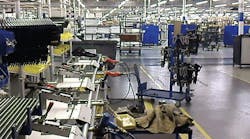Take a tour of La-Z-Boy's Dayton, Tenn., facility with David Robinson, the plant's continuous improvement manager, and be prepared for a bit of temporal distortion. For as proud as Robinson is of the facility's current operations, his heart belongs to its "future state."
The Dayton facility produces a wide range of upholstered furniture, including the famous La-Z-BoyIn the manufacturing cells, employees build the frames, stuff and seal the polyurethane into previously cut and sewn components, and upholster each component. The finished furniture is inspected and then packed for delivery. Each cell team of six to eight employees operates on an incentive basis and is managed by a "coach" who supervises up to five teams.
In an American furniture industry decimated by foreign competition, a determined drive for cost efficiency and continuous improvement has allowed La-Z-Boy to flourish, even during the Great Recession. "If we were doing business the same way we did in 2005, somebody else would be here because we would already be closed," Robinson observes. "We are $50 million a year better now than we were."
La-Z-Boy has taken on the competitive challenge through its people, equipment and processes. Robinson says it is important to establish a lean culture in the facility, not just employ lean tools. To that end, both managers and employees have been trained in lean concepts and involved in operational improvement efforts. For example, 23 managers and engineers have been trained in Six Sigma. Cross-functional teams completed 24 kaizen events focused on safety, quality and productivity.
One of the process improvements the Dayton facility has implemented is its Flawless Launch Program, designed to build quality and manufacturability into new products. A production engineer is dedicated to ensuring products are designed for manufacturing and assembly.
Robinson acknowledges the plant has not had a flawless launch, but it has made great strides in reducing defects. He points to the plant's first effort at launching an electric lift chair. The first lift chair had about a 40% failure rate in the field. La-Z-Boy redesigned it and the second model had a 17% failure rate. The third time around, the plant used the flawless launch process. "We now have a fraction of 1% failure in the field," he reports.
The Dayton facility has extended its continuous improvement efforts to its supply chain. The plant uses a supplier scorecard to evaluate performance on quality, delivery and cost. The plant established a supplier kaizen support team that travels to supplier facilities and helps identify opportunities to reduce waste. Companies that fail to cooperate with La-Z-Boy on cost-cutting initiatives may find themselves losing a customer. For example, the plant buys round steel tubing from a supplier. The tubing was too oily on delivery and was contaminating a detergent bath used to clean it. Robinson asked to work with the supplier to find a way to reduce the oil, but the supplier refused. Robinson plans to install machinery to make the tubing.
Other "future state" plans include building a centralized parts distribution center at the site, changing the size of manufacturing cells and installing additional automation, introducing iPads for the parts picking process, and manufacturing boxes and staples. They all boil down to a simple ambition, Robinson explains. "We want to be great."




